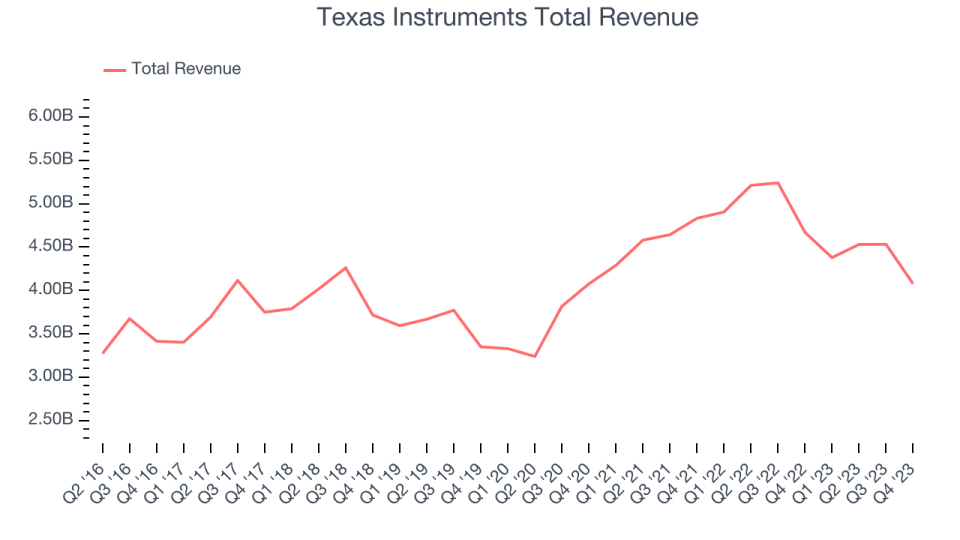Texas Instruments (NASDAQ:TXN) Misses Q4 Analysts' Revenue Estimates

Analog chip manufacturer Texas Instruments (NASDAQ:TXN) fell short of analysts' expectations in Q4 FY2023, with revenue down 12.7% year on year to $4.08 billion. Next quarter's revenue guidance of $3.6 billion also underwhelmed, coming in 11.2% below analysts' estimates. It made a GAAP profit of $1.49 per share, down from its profit of $2.19 per share in the same quarter last year.
Is now the time to buy Texas Instruments? Find out by accessing our full research report, it's free.
Texas Instruments (TXN) Q4 FY2023 Highlights:
Market Capitalization: $158.8 billion
Revenue: $4.08 billion vs analyst estimates of $4.13 billion (1.4% miss)
EPS: $1.49 vs analyst estimates of $1.47 (1.7% beat)
Revenue Guidance for Q1 2024 is $3.6 billion at the midpoint, below analyst estimates of $4.05 billion
Free Cash Flow of $776 million, up 75.6% from the previous quarter
Inventory Days Outstanding: 221, up from 207 in the previous quarter
Gross Margin (GAAP): 59.6%, down from 66.1% in the same quarter last year
Headquartered in Dallas, Texas since the 1950s, Texas Instruments (NASDAQ:TXN) is the world’s largest producer of analog semiconductors.
Analog Semiconductors
Demand for analog chips is generally linked to the overall level of economic growth, as analog chips serve as the building blocks of most electronic goods and equipment. Unlike digital chip designers, analog chip makers tend to produce the majority of their own chips, as analog chip production does not require expensive leading edge nodes. Less dependent on major secular growth drivers, analog product cycles are much longer, often 5-7 years.
Sales Growth
Texas Instruments's revenue growth over the last three years has been unremarkable, averaging 8.2% annually. This quarter, its revenue declined from $4.67 billion in the same quarter last year to $4.08 billion. Semiconductors are a cyclical industry, and long-term investors should be prepared for periods of high growth followed by periods of revenue contractions (which can sometimes offer opportune times to buy).

Texas Instruments had a difficult quarter as revenue dropped 12.7% year on year, missing analysts' estimates by 1.4%. This could mean that the current downcycle is deepening.
Texas Instruments looks like it's on the cusp of a rebound, as it's guiding to 21.6% year-on-year revenue growth for the next quarter. Analysts seem to agree as consesus estimates call for 0.5% growth over the next 12 months.
Our recent pick has been a big winner, and the stock is up more than 2,000% since the IPO a decade ago. If you didn’t buy then, you have another chance today. The business is much less risky now than it was in the years after going public. The company is a clear market leader in a huge, growing $200 billion market. Its $7 billion of revenue only scratches the surface. Its products are mission critical. Virtually no customers ever left the company. You can find it on our platform for free.
Product Demand & Outstanding Inventory
Days Inventory Outstanding (DIO) is an important metric for chipmakers, as it reflects a business' capital intensity and the cyclical nature of semiconductor supply and demand. In a tight supply environment, inventories tend to be stable, allowing chipmakers to exert pricing power. Steadily increasing DIO can be a warning sign that demand is weak, and if inventories continue to rise, the company may have to downsize production.

This quarter, Texas Instruments's DIO came in at 221, which is 71 days above its five-year average, suggesting that the company's inventory has grown to higher levels than we've seen in the past.
Key Takeaways from Texas Instruments's Q4 Results
We struggled to find many strong positives in these results. Its revenue and free cash flow missed analysts' estimates, driven by weakness in its industrial and automotive end markets. On top of that, its guidance for next quarter missed Wall Street's expectations. Overall, this was a mediocre quarter for Texas Instruments. The company is down 3.7% on the results and currently trades at $168 per share.
Texas Instruments may not have had the best quarter, but does that create an opportunity to invest right now? When making that decision, it's important to consider its valuation, business qualities, as well as what has happened in the latest quarter. We cover that in our actionable full research report which you can read here, it's free.
One way to find opportunities in the market is to watch for generational shifts in the economy. Almost every company is slowly finding itself becoming a technology company and facing cybersecurity risks and as a result, the demand for cloud-native cybersecurity is skyrocketing. This company is leading a massive technological shift in the industry and with revenue growth of 50% year on year and best-in-class SaaS metrics it should definitely be on your radar.
